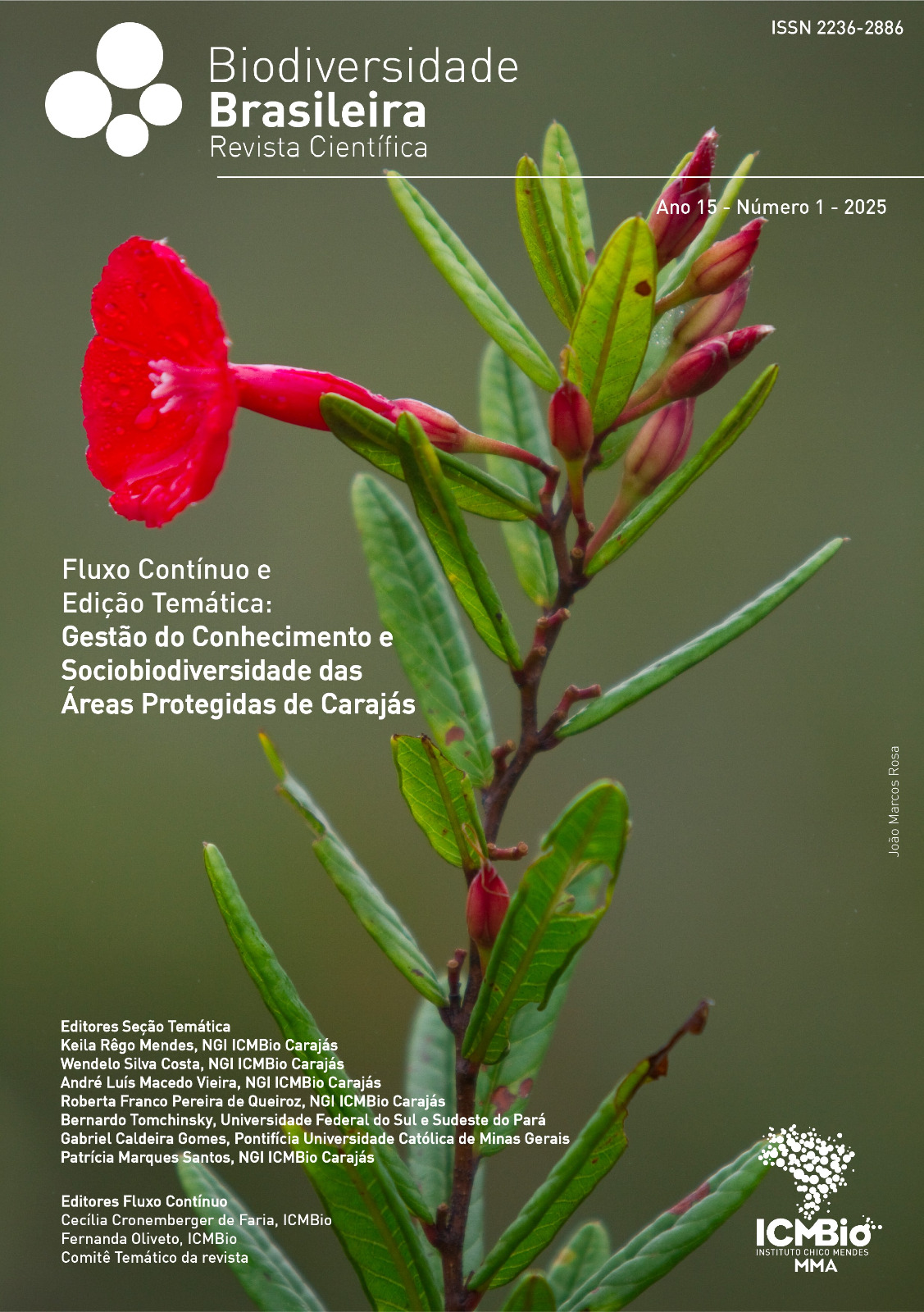Tourism for observation of the long-snouted seahorse Hippocampus reidi (Ginsburg, 1933) in the Jericoacoara National Park
management actions for conservation of the species
DOI:
https://doi.org/10.37002/biodiversidadebrasileira.v15i1.2644Keywords:
Endangered species, community tourism, wildlife watching, monitoringAbstract
Seahorse watching tourism is an attraction of the Jericoacoara National Park (PNJ), carried out in partnership with the local communities. The pratice of capture and temporary containment can cause stress to individuals of Hippocampus reidi, a species considered vulnerable (VU) to the risk of extinction. This present study aimed to establish guidelines for the protection of H. reidi in the PNJ and to describe the socio-environmental aspects of the activity. Between 2020 and 2024, the seahorse population was monitored at the three points of embarkation for the tours. In 2022, the cruises were accompanied by volunteer observers who described the social, environmental and economic aspects of the activity. At Point 1 we observed the lowest average number of visitors, the lowest gross revenue and the highest number of authorized drivers. At Point 3 we observed the greatest irregularities from an environmental point of view and the highest number of visitors and, consequently, the highest revenue. At Point 2 we recorded the shortest containment time for H. reidi individuals, but the visitation strategies had the greatest environmental impact. During the sample period, we carried out 26 seahorse population monitoring campaigns, observing a total of 121 individuals, 63 males and 58 females. At the beginning of the 2010s, the monitoring recorded hundreds of individuals, which dropped to just a few in this study. This population decline is seen throughout Brazil, justifying a special strategy for protecting the species in the PNJ, with a ban on capturing, adopting the principle of observing the fauna in its natural environment without direct interaction.
Downloads
References
1. Haanpää M, Salmela T, García-Rosell JC, Äijälä M. The disruptive ‘other’? Exploring human-animal relations in tourism through videography. Tourism Geographies. 2021;23(1-2):97-117. DOI: https://doi.org/10.1080/14616688.2019.1666158
2. Ternes MLF, Gerhardinger LC, Schiavetti A. Seahorses in focus: local ecological knowledge of seahorse-watching operators in a tropical estuary. J Ethnobiology Ethnomedicine. 2016;12(1):1-12. DOI: https://doi.org/10.1186/s13002-016-0125-8
3. Vincent ACJ, Foster SJ, Koldewey HJ. Conservation and management of seahorses and other Syngnathidae. Journal of Fish Biology. 2011;78(6):1681-1724. DOI: https://doi.org/10.1111/j.1095-8649.2011.03003.x
4. Camargo CFD, Coelho SCA. Aspectos da educação e da interpretação ambiental no Ecoturismo no Brasil. RBEcotur [Internet]. 2021 January [cited 2024 Set 13];14(1). Available from: https://periodicos.unifesp.br/index.php/ecoturismo/article/view/6766 DOI: https://doi.org/10.34024/rbecotur.2021.v14.6766
5. Martins JC, Fontana A, Silveira RB, Vidal MD. Trajetória e Perspectivas do Turismo com Cavalos-Marinhos no Parque Nacional de Jericoacoara, Ceará. BioBrasil. 2022 April; 12(3): 234-248. doi: 10.37002/biobrasil.v12i3.1988 DOI: https://doi.org/10.37002/biodiversidadebrasileira.v12i3.1988
6. Ballantyne R, Packer J, Hughes K, Dierking L. Conservation learning in wildlife tourism settings: lessons from research in zoos and aquariums. Environmental Education Research. 2007;13(3):367-383. doi: 10.1080/13504620701430604 DOI: https://doi.org/10.1080/13504620701430604
7. Brumatti PNM. O papel do turismo de observação da vida selvagem para a conservação da natureza. Revista Brasileira de Ecoturismo RBEcotur. 2013;6(4):191-206. DOI: https://doi.org/10.34024/rbecotur.2013.v6.6377
8. Rosa IL, Oliveira TPR, Castro ALC, Moraes LE, Dias TLP, Nottingham MC, Xavier JHA, Bruto-Costa LV, Birolo AB, Mai ACG, Monteiro-Neto C. Population characteristics, space use and habitat associations of the seahorse Hippocampus reidi (Teleostei: Syngnathidae). Neotrop ichthyol. 2007;5(3):405-414. doi: 10.1590/S1679-62252007000300020 DOI: https://doi.org/10.1590/S1679-62252007000300020
9. Aylesworth LA, Xavier JH, Oliveira TPR, Tenorio GD, Diniz AF, Rosa IL. Regional-scale patterns of habitat preference for the seahorse Hippocampus reidi in the tropical estuarine environment. Aquat Ecol. 2015 December;49(4):499-512. doi:10.1007/s10452-015-9542-3 DOI: https://doi.org/10.1007/s10452-015-9542-3
10. Lourie SA, Foster SJ, Cooper EWT, Vicent ACJ. A Guide to the Identification of Seahorses [Internet]. Project Seahorse and TRAFFIC North America. Washington D.C.: University of British Columbia and World Wildlife Fund; 2004. Available from: https://www.hippocampus-institute.org/wp-content/uploads/2019/02/bibliography-2004-Seahorse-ID-Guide.pdf
11. Foster SJ, Vincent ACJ. Life history and ecology of seahorses: implications for conservation and management. Journal of Fish Biology. 2004 July;65(1):1-61. doi:10.1111/j.0022-1112.2004.00429.x DOI: https://doi.org/10.1111/j.0022-1112.2004.00429.x
12. Felício AKC, Rosa IL, Souto A, Freitas RHA. Feeding behavior of the longsnout seahorse Hippocampus reidi Ginsburg, 1933. J Ethol. 2006 July;24(3):219-225. doi:10.1007/s10164-005-0189-8 DOI: https://doi.org/10.1007/s10164-005-0189-8
13. Castro ALDC, Diniz ADF, Martins IZ, Vendel AL, Oliveira TPRD, Rosa IMDL. Assessing diet composition of seahorses in the wild using a non destructive method: Hippocampus reidi (Teleostei: Syngnathidae) as a study-case. Neotrop ichthyol. 2008 December;6(4):637-644. doi:10.1590/S1679-62252008000400012 DOI: https://doi.org/10.1590/S1679-62252008000400012
14. Roos G, Van Wassenbergh S, Herrel A, Aerts P. Kinematics of suction feeding in the seahorse Hippocampus reidi. Journal of Experimental Biology. 2009 November;212(21):3490-3498. doi:10.1242/jeb.033050 DOI: https://doi.org/10.1242/jeb.033050
15. Schaeffer-Novelli Y, Cintrón-Molero G, Soares MLG, De-Rosa T. Brazilian mangroves. Aquatic Ecosystem Health & Management. 2000 January;3(4):561–70. DOI: https://doi.org/10.1080/14634980008650693
16. Novelli B, Socorro JA, Caballero MJ, Otero-Ferrer F, Segade-Botella A, Molina Domínguez L. Development of seahorse (Hippocampus reidi, Ginsburg 1933): histological and histochemical study. Fish Physiol Biochem. 2015 October;41(5):1233-1251. doi: 10.1007/s10695-015-0082-5 DOI: https://doi.org/10.1007/s10695-015-0082-5
17. Duarte M, Gawryszewski FM, Ramineli S, Bessa E. Disruptive coloration and habitat use by seahorses. Neotrop ichthyol. 2019;17(4):e190064. doi: 10.1590/1982-0224-20190064 DOI: https://doi.org/10.1590/1982-0224-20190064
18. Lourie SA, Pollom RA, Foster SJ. A global revision of the Seahorses Hippocampus Rafinesque 1810 (Actinopterygii: Syngnathiformes): Taxonomy and biogeography with recommendations for further research. Zootaxa [Internet]. 2016 August;4146(1). doi:10.11646/zootaxa.4146.1.1 DOI: https://doi.org/10.11646/zootaxa.4146.1.1
19. Dias TLP, Rosa IL. Habitat preferences of a seahorse species, Hippocampus reidi (Teleostei: Syngnathidae) in Brazil. Aqua, Journal of Ichthyology and Aquatic Biology, 2003;6(4):165–176.
20. Hercos AP, Giarrizzo T. Pisces, Syngnathidae, Hippocampus reidi: filling distribution gaps. Check List. 2007 October;3(4): 287-290. DOI: https://doi.org/10.15560/3.4.287
21. Silveira RB, Santos Silva JR, Santos L, Martins JC, Garcia AL, Montes MA, Vidal MD. Avaliação dos Parâmetros Populacionais de Cavalos-marinhos em Áreas com e sem Turismo em Áreas Marinhas Protegidas Federais no Nordeste do Brasil. BioBrasil [Internet]. 2022 December 23;12(4):1-18. doi:10.37002/biobrasil.v12i4.2278 DOI: https://doi.org/10.37002/biobrasil.v12i4.2278
22. Zhang X, Vincent ACJ. Using cumulative human‐impact models to reveal global threat patterns for seahorses. Conservation Biology. 2019;33(6):1380-1391. doi:10.1111/cobi.13325 DOI: https://doi.org/10.1111/cobi.13325
23. Harasti D. Declining seahorse populations linked to loss of essential marine habitats. Mar Ecol Prog Ser. 2016 March 21;546:173–81. doi: 10.3354/meps11619 DOI: https://doi.org/10.3354/meps11619
24. Lawson JM. The Global Search for Seahorses in Bycatch. Fisheries. 2017;42(1):34-39. doi:10.1080/03632415.2017.1273660 DOI: https://doi.org/10.1080/03632415.2017.1273660
25. IUCN [homepage na internet]. Hippocampus reidi: The IUCN Red List of Threatened Species 2017: e.T10082A17025021. [cited 2024 Jun 13]. Available from: http://www.iucnredlist.org/details/10082/0
26. Olden JD, Hogan ZS, Zanden MJV. Small fish, big fish, red fish, blue fish: size‐biased extinction risk of the world’s freshwater and marine fishes. Global Ecology and Biogeography. 2007;16(6):694-701. doi:10.1111/j.1466-8238.2007.00337.x DOI: https://doi.org/10.1111/j.1466-8238.2007.00337.x
27. Domínguez-López M, Bellas J, Sánchez-Ruiloba L, Planas M, Hernández-Urcera J. First evidence of ingestion and retention of microplastics in seahorses (Hippocampus reidi) using copepods (Acartia tonsa) as transfer vectors. Science of The Total Environment. 2022 April; 818:151688. doi:10.1016/j.scitotenv.2021.151688 DOI: https://doi.org/10.1016/j.scitotenv.2021.151688
28. Portaria MMA n. 148, de 7 de junho de 2022 (Brasil). Altera os Anexos da Portaria n. 443, de 17 de dezembro de 2014, da Portaria n. 444, de 17 de dezembro de 2014, e da Portaria n. 445, de 17 de dezembro de 2014, referentes à atualização da Lista Nacional de Espécies Ameaçadas de Extinção. [Internet]. Diário Oficial da União. 2022 jun. 7 [citado 2024 jun. 10]. Available from: https://www.icmbio.gov.br/cepsul/images/stories/legislacao/Portaria/2020/P_mma_148_2022_altera_anexos_P_mma_443_444_445_2014_atualiza_especies_ameacadas_extincao.pdf
30. Lourie SA, Vincent ACJ, Hall H. Seahorses: An identification guide to the world’s species and their conservation. London: Project Seahorse; 1999.
31. Portaria MMA/ICMBio n. 769, de 10 de dezembro de 2019 (Brasil). Dispõe sobre normas e procedimentos administrativos para Autorização da prestação do serviço de condução de visitantes em unidades de conservação federais. [Internet]. Diário Oficial da União. 2019 dez. 7 [citado 2024 jun. 10]. Available from: https://www.gov.br/icmbio/pt-br/assuntos/biodiversidade/unidade-de-conservacao/unidades-de-biomas/cerrado/lista-de-ucs/parna-da-chapada-dos-veadeiros/arquivos/Portaria_ICMBio_769_2019_conduo_visitantes.pdf
32. Portaria MMA/ICMBio n. 579 de 11 de outubro de 2017 (Brasil). Estabelece normas e procedimentos para o cadastramento e a autorização de uso para o exercício das atividades comerciais de condução de visitantes e condução embarcada de visitantes para o passeio ecológico do cavalo-marinho no Parque Nacional de Jericoacoara [Internet]. Diário Oficial da União. 2017 out. 11. [citado 2024 jun. 10]. Available from: https://www.gov.br/icmbio/pt-br/acesso-a-informacao/institucional/legislacao/portarias/portarias-2017/portaria_579_de_11_de_outubro_de_2017.pdf.
33. Portaria MMA/ICMBio n. 289, de 3 de maio de 2021. Dispõe sobre as normas gerais para o planejamento e a implementação do uso público nas unidades de conservação federais[Internet] . Diário Oficial da União. 2021 maio 3. [citado 2024 jun. 10]. Disponível em: https://www.gov.br/icmbio/pt-br/assuntos/criacao-de-unidades-de-conservacao/legislacao/portaria_289_de_3_de_maio_de_2021_planejamento.pdf
34. Ternes MLF, Freret-Meurer NV, Nascimento RL, Vidal MD, Giarrizzo T. Local ecological knowledge provides important conservation guidelines for a threatened seahorse species in mangrove ecosystems. Front Mar Sci. 2023 jun 12;10:1139368. doi:10.3389/fmars.2023.1139368 DOI: https://doi.org/10.3389/fmars.2023.1139368
Downloads
Published
Issue
Section
License
Copyright (c) 2025 Os autores mantêm os direitos autorais de seus artigos sem restrições, concedendo ao editor direitos de publicação não exclusivos.

This work is licensed under a Creative Commons Attribution-NonCommercial-NoDerivatives 4.0 International License.
Os artigos estão licenciados sob uma licença Creative Commons Atribuição-NãoComercial-SemDerivações 4.0 Internacional (CC BY-NC-ND 4.0). O acesso é livre e gratuito para download e leitura, ou seja, é permitido copiar e redistribuir o material em qualquer mídia ou formato.












